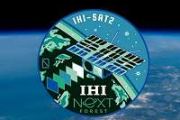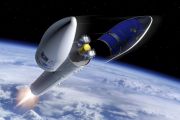
Copernical Team
Top innovators at Watts on the Moon Challenge awarded $1.5M
 Great Lakes Science Center, which serves as the visitor center for NASA's Glenn Research Center in Cleveland, hosted the final phase of NASA's Watts on the Moon Challenge on September 20. NASA astronaut Stephen Bowen was present to recognize the top winners.
NASA distributed a total of $1.5 million in awards to two U.S. teams for their innovative solutions in energy distribution, managemen
Great Lakes Science Center, which serves as the visitor center for NASA's Glenn Research Center in Cleveland, hosted the final phase of NASA's Watts on the Moon Challenge on September 20. NASA astronaut Stephen Bowen was present to recognize the top winners.
NASA distributed a total of $1.5 million in awards to two U.S. teams for their innovative solutions in energy distribution, managemen Beware of the full moon Tropical forest mammals shy away from the moonlight
 A recent study using automatic wildlife cameras across three continents has shed light on how the moon's phases affect the behaviour of tropical forest mammals. Half of the species studied altered their activity levels or timing, or both, in response to the full moon. The findings suggest that even in some of the darkest places on earth - the floors of tropical forests - the moon's phases can in
A recent study using automatic wildlife cameras across three continents has shed light on how the moon's phases affect the behaviour of tropical forest mammals. Half of the species studied altered their activity levels or timing, or both, in response to the full moon. The findings suggest that even in some of the darkest places on earth - the floors of tropical forests - the moon's phases can in Maritime Launch and Reaction Dynamics partner to advance Canadian orbital launch capabilities
 Maritime Launch Services Ltd. (Maritime Launch) (Cboe CA: MAXQ, OTCQB: MAXQF) and Reaction Dynamics (RDX) have announced a new phase in their partnership, marked by an agreement to pursue future orbital launches from Canada.
The collaboration will start with a pathfinder mission aiming to reach the Karman Line, the recognized boundary of space, as a precursor to achieving future orbital la
Maritime Launch Services Ltd. (Maritime Launch) (Cboe CA: MAXQ, OTCQB: MAXQF) and Reaction Dynamics (RDX) have announced a new phase in their partnership, marked by an agreement to pursue future orbital launches from Canada.
The collaboration will start with a pathfinder mission aiming to reach the Karman Line, the recognized boundary of space, as a precursor to achieving future orbital la SpaceX launches 23 more Starlink satellites into orbit
 SpaceX successfully launched 23 Starlink Internet satellites early Tuesday, lifting off from Florida's Cape Canaveral Space Force Station at around 2:10 a.m. EDT. The Falcon 9 rocket carried the satellites into low-Earth orbit, adding to the ever-expanding constellation aimed at providing global high-speed Internet coverage.
The mission began with the rocket launching from Space Launch Com
SpaceX successfully launched 23 Starlink Internet satellites early Tuesday, lifting off from Florida's Cape Canaveral Space Force Station at around 2:10 a.m. EDT. The Falcon 9 rocket carried the satellites into low-Earth orbit, adding to the ever-expanding constellation aimed at providing global high-speed Internet coverage.
The mission began with the rocket launching from Space Launch Com Reaction Dynamics to test hybrid rocket engine in 2025 launch from Koonibba
 Canadian rocket company Reaction Dynamics has partnered with Southern Launch to perform the first flight of its RE-102 hybrid rocket engine and Aurora vehicle from the Koonibba Test Range in 2025. This inaugural suborbital mission will qualify the rocket engine for space, reaching 125 km above Earth. It aims to provide key data and demonstrate the company's readiness for future orbital missions.
Canadian rocket company Reaction Dynamics has partnered with Southern Launch to perform the first flight of its RE-102 hybrid rocket engine and Aurora vehicle from the Koonibba Test Range in 2025. This inaugural suborbital mission will qualify the rocket engine for space, reaching 125 km above Earth. It aims to provide key data and demonstrate the company's readiness for future orbital missions. Sandia evaluates heat shields for Mars Sample Return and Titan missions
 Sandia National Laboratories' National Solar Thermal Test Facility is utilizing solar energy to simulate the intense heat experienced during atmospheric reentry and hypersonic flight. The latest tests aim to support NASA missions, including the Mars Sample Return campaign, a joint effort with the European Space Agency to bring Martian rock samples to Earth for analysis. These samples could revea
Sandia National Laboratories' National Solar Thermal Test Facility is utilizing solar energy to simulate the intense heat experienced during atmospheric reentry and hypersonic flight. The latest tests aim to support NASA missions, including the Mars Sample Return campaign, a joint effort with the European Space Agency to bring Martian rock samples to Earth for analysis. These samples could revea EarthCARE synergy reveals power of clouds and aerosols

With the initial images from each of the instruments aboard ESA’s EarthCARE satellite now in hand, it's time to reveal how these four advanced sensors work in synergy to measure exactly how clouds and aerosols influence the heating and cooling of our atmosphere.
Tsuchinshan-Atlas comet visible with naked eye this month
This request seems a bit unusual, so we just need to confirm you're human. Please complete the slider CAPTCHA by dragging it to the right. Thank you for your understanding!
If you believe this is an error, please contact our support team.
185.132.36.159 : b25b7fa9-73cf-4840-9e18-bb3cb4bc
NASA seeks innovative Artemis lunar logistics, mobility solutions
This request seems a bit unusual, so we just need to confirm you're human. Please complete the slider CAPTCHA by dragging it to the right. Thank you for your understanding!
If you believe this is an error, please contact our support team.
185.132.36.159 : 51cd2bba-fd01-4031-982e-e96d3671
Instrument aboard Jupiter-bound spacecraft nails in-flight test
This request seems a bit unusual, so we just need to confirm you're human. Please complete the slider CAPTCHA by dragging it to the right. Thank you for your understanding!
If you believe this is an error, please contact our support team.
185.132.36.159 : 2d43c773-e7fc-4f40-b460-2b977485






























